
James Holland stands as a significant figure in nineteenth-century British art, celebrated particularly for his evocative depictions of Venice rendered in luminous watercolour and rich oil paint. Born into the heart of England's pottery district, his artistic journey took him from decorating ceramics to becoming a respected member of London's art establishment and a frequent traveller across Europe. Though perhaps overshadowed during his lifetime by giants like J.M.W. Turner, Holland's sensitivity to atmosphere, his masterful handling of colour, and his particular affinity for the decaying grandeur of Venice have secured him a lasting place in the annals of British art history. His work bridges the gap between the topographical tradition and a more Romantic, atmospheric approach to landscape and architectural painting.
Early Life in the Potteries and the Move to London
James Holland entered the world in Burslem, Staffordshire, in 1800. This region, known colloquially as "The Potteries," was the epicentre of ceramic production in Britain, a place where art and industry intertwined. Holland's family was directly involved in this trade; his early years were spent working in his mother's pottery workshop. From a young age, certainly by the age of 12, he was learning the craft of painting flowers onto pottery and porcelain. This early training, focused on precision, decorative effect, and the handling of pigments on a smooth surface, likely provided a foundational discipline that would inform his later work in fine art, particularly his detailed architectural studies and his vibrant floral pieces.
However, the young Holland harboured ambitions beyond the ceramic industry. Seeking broader artistic horizons, he made the pivotal decision to move to London around 1819. The metropolis offered vastly greater opportunities for an aspiring artist. Initially, he supported himself by continuing to paint flowers, likely finding work decorating various items or perhaps teaching this skill. He also began teaching drawing more generally. London exposed him to a vibrant art scene, including major institutions like the Royal Academy of Arts and the burgeoning societies dedicated to watercolour painting. This environment undoubtedly fuelled his transition towards becoming a professional painter focused on landscapes, architectural views, and marine subjects.
Artistic Development: From Flowers to Landscapes
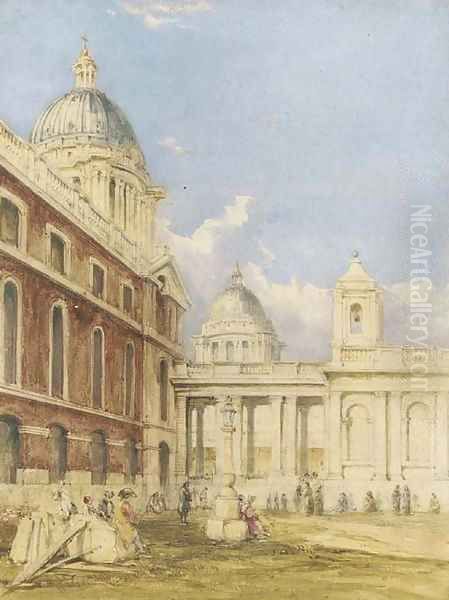
Holland's initial foray into the London art world saw him exhibiting flower paintings. These works, drawing on his pottery decoration background, were likely detailed and colourful. He first exhibited at the Royal Academy in 1824, marking his formal entry into the established art scene. However, his artistic interests soon broadened considerably. He began to explore landscape painting, initially focusing on scenes within Britain, including views along the River Thames and studies of London's architecture and environs. A notable early example includes his View of Greenwich Hospital, showcasing his growing ability to handle complex architectural forms and atmospheric conditions.
He embraced both oil painting and watercolour, demonstrating proficiency in each, although it was his work in watercolour that would eventually bring him the most acclaim. The rise of watercolour painting as a serious artistic medium was a defining feature of the British art scene in the early nineteenth century, championed by artists like Thomas Girtin and J.M.W. Turner. Holland became part of this movement. He also undertook commissions for book illustrations, a common practice for artists of the period, which required versatility and narrative skill. His subject matter expanded to include coastal and marine scenes, reflecting another popular genre in British art, mastered by contemporaries such as Clarkson Stanfield.
The Allure of Venice: Capturing the Floating City
A defining moment in Holland's career came with his first visit to Venice in 1835. Like countless artists before and after him, from Canaletto in the eighteenth century to John Singer Sargent later in the nineteenth, Holland was captivated by the unique beauty, light, and atmosphere of the city. Venice, with its shimmering canals, decaying palazzi, and dramatic interplay of light and water, offered endless inspiration. This visit marked the beginning of a lifelong fascination, and Venetian subjects would become central to his oeuvre and reputation.
Holland returned to Venice on several occasions throughout his career. His depictions of the city are distinct from the precise, almost photographic vedute of Canaletto. Instead, Holland adopted a more Romantic and atmospheric approach, focusing on the overall mood, the quality of light, and the richness of colour. He was particularly adept at capturing the hazy, moisture-laden air, the reflections in the water, and the textures of weathered stone and plaster. His Venetian watercolours often employ fluid washes, vibrant hues, and sometimes bodycolour (gouache) to achieve highlights and opacity, creating a sense of immediacy and brilliance.
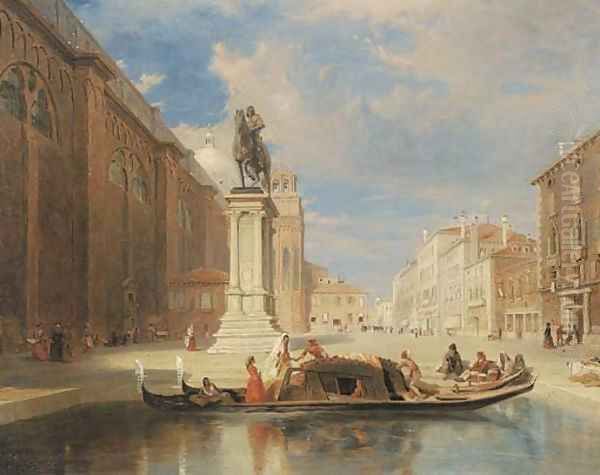
His oil paintings of Venice share this focus on light and colour but often have a richer, more substantial feel, sometimes using thicker applications of paint (impasto) to convey texture. Works like San Trovo Boatyard, Venice exemplify his interest not just in the grand landmarks but also in the everyday life and working areas of the city, rendered with warmth and character. He captured famous sites like the Doge's Palace, St Mark's Square, and the Rialto Bridge, but always infused them with his personal vision, emphasizing atmosphere over strict topographical accuracy. His Venetian scenes were highly esteemed, particularly in the later nineteenth century, contributing significantly to his posthumous reputation.
Artistic Style and Technical Approach
James Holland's style evolved throughout his career but consistently demonstrated a remarkable sensitivity to light and colour. He is often associated with the broader British School of landscape painting, which flourished in the nineteenth century, encompassing artists from John Constable with his naturalistic studies of the English countryside to the sublime visions of Turner. Holland's work, particularly his watercolours, aligns with the tradition established by earlier masters like David Cox and Peter De Wint, who explored the expressive potential of the medium.
His watercolours are characterized by their luminosity and often bold colour choices. He wasn't afraid to use strong blues, reds, and yellows, especially in his Venetian scenes, to convey the intensity of the southern light. His technique involved both transparent washes, allowing the white of the paper to shine through and create brilliance, and the judicious use of opaque bodycolour for highlights and textural effects. This combination gave his watercolours depth and vibrancy.
In his oil paintings, Holland displayed a similar concern for atmospheric effects. His brushwork could range from detailed rendering in architectural passages to looser, more expressive handling in skies and water. He built up layers of paint to achieve richness and depth, paying close attention to the way light interacted with surfaces. His style shows some affinity with the work of Richard Parkes Bonington, another British artist known for his fluid handling of paint and atmospheric landscapes, particularly scenes from France and Italy. Indeed, the similarity in their styles and subject matter occasionally led to confusion between their works. Holland, however, developed his own distinct voice, marked by a particular warmth and a delight in the picturesque aspects of his subjects.
Travels Beyond Venice: Broadening Horizons
While Venice remained a primary source of inspiration, Holland's artistic curiosity led him to travel extensively elsewhere in Europe. These journeys provided fresh subject matter and further honed his skills in capturing diverse landscapes and architectural styles. In 1831, he made his first trip to France, visiting Paris. This journey likely exposed him to contemporary French art and provided new architectural and urban scenes to depict.
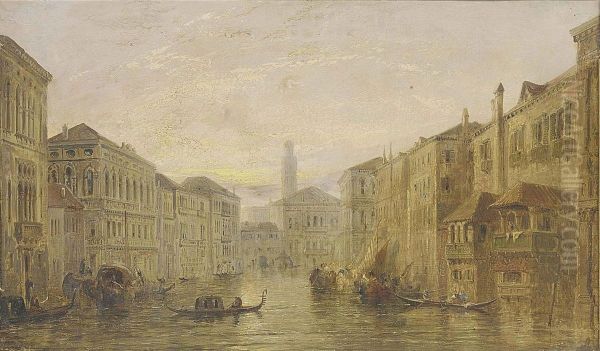
Later travels took him to Portugal in 1837, a less common destination for British artists at the time. His sketches and paintings from Oporto and Lisbon capture the unique character of Portuguese cities, with their colourful buildings and bustling river life. A trip to the Netherlands followed in 1845, where he sketched in Rotterdam, likely drawn to the canals and maritime activity that echoed aspects of Venice but with a different northern light and atmosphere. He also visited Geneva in 1850 and Normandy in 1851. A government-commissioned trip took him back to Portugal in 1847. His final significant journey abroad was to Austria and Venice in 1857.
These travels enriched his portfolio and demonstrated his versatility. Whether depicting the bustling quays of Rotterdam, the sun-drenched hills around Lisbon, or the tranquil waters of Lake Geneva, Holland brought his characteristic sensitivity to light and place. His travel sketches, often executed quickly on the spot, possess a freshness and immediacy that complements his more finished studio works. These journeys place him firmly within the tradition of nineteenth-century artists who sought inspiration through travel, following in the footsteps of earlier generations who embarked on the Grand Tour and contemporaries like David Roberts, famed for his views of Spain and the Near East.
Professional Life, Exhibitions, and Recognition
James Holland actively participated in the London art world throughout his career. He began exhibiting at the Royal Academy of Arts in 1824 and continued to show works there periodically until 1865. He also exhibited at the British Institution and the Society of British Artists (SBA), ensuring his work was seen by a wide audience of collectors, critics, and fellow artists.
His affiliation with the watercolour societies was particularly important. He was elected an Associate Exhibitor of the Society of Painters in Water Colours (often known as the Old Watercolour Society or RWS) in 1835. He contributed regularly to their exhibitions, showcasing his developing skill in the medium. Interestingly, he resigned from the society in 1843 but rejoined in 1856, becoming a full Member in 1858. He remained a member until shortly before his death in 1870. This long association underscores the importance of watercolour to his practice and reputation.
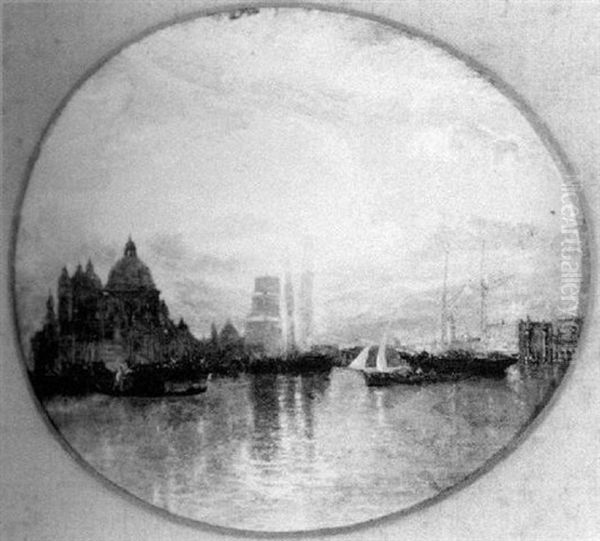
Despite his regular exhibition activity and the clear quality of his work, Holland did not achieve the same level of fame or financial success as some of his contemporaries during his lifetime. His style, while accomplished, perhaps lacked the dramatic impact of Turner or the overt sentimentality favoured by some Victorian tastes. However, his work was appreciated by discerning collectors and fellow artists. The influential critic John Ruskin, a major champion of Turner and Venetian subjects, owned works by Holland. Following his death in 1870, Holland's reputation grew, particularly his status as a colourist. He came to be regarded as one of the finest painters of Venice in the British school, admired for his ability to capture its unique essence with vibrancy and sensitivity. Later watercolourists like Myles Birket Foster, known for his detailed rural scenes, worked within the tradition that Holland helped to shape.
Representative Works: A Glimpse into Holland's World
Several key works illustrate James Holland's artistic range and mastery:
Early Flower Studies (c. 1820s-1830s): Though less famous than his later landscapes, these pieces demonstrate his roots in ceramic decoration and his skill in detailed botanical representation. They show a fine touch and an eye for colour and form.
View of Greenwich Hospital (c. 1830s): An example of his British topographical work, showcasing his ability to handle complex architecture and create a sense of place within a London setting. It demonstrates his competence in oil painting early in his landscape career.
The Colleoni Monument, Venice (various versions, post-1835): Holland painted this famous equestrian statue and its surrounding Scuola Grande di San Marco multiple times. These works highlight his interest in Venetian architecture and sculpture, often bathed in warm light, emphasizing the textures of stone and the bustling life of the Campo Santi Giovanni e Paolo.
San Trovo Boatyard, Venice (various versions, post-1835): This subject reveals Holland's interest in the less monumental, working aspects of Venice. His depictions of the gondola repair yard are full of character, capturing the clutter of boats, timber, and workshops under the Venetian sun, often with rich colours and lively brushwork.
Oporto (or Porto) Scenes (c. 1837 onwards): His paintings and watercolours from Portugal capture the distinctive architecture and vibrant atmosphere of the city on the Douro River. They often feature the colourful tiled buildings, the river traffic, and the dramatic bridges, showcasing his ability to adapt his style to different locations.
Rotterdam Views (c. 1845 onwards): These works capture the busy port city of the Netherlands, focusing on canals, shipping, and windmills. They demonstrate his skill in marine painting and his ability to render the cooler light and different architectural styles of Northern Europe.
Temple of Mars Ultor, Rome: Although primarily known for Venice, Holland also depicted other Italian cities. This work shows his engagement with classical antiquity, a common theme for artists visiting Italy, rendered with his characteristic attention to light and architectural detail.
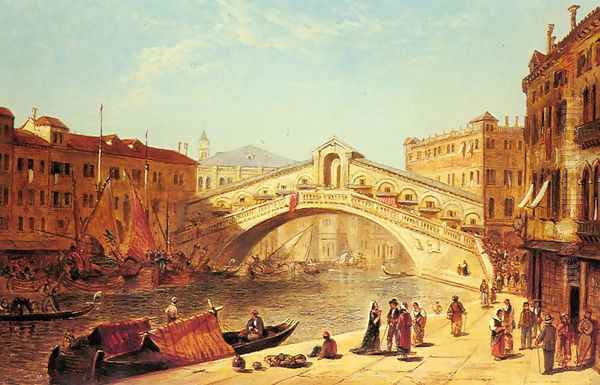
These examples, among many others, illustrate Holland's versatility in subject matter – from flowers to grand architecture, bustling ports to tranquil canals – and his consistent mastery of light and colour across different mediums and locations.
Legacy and Collections: Holland's Enduring Appeal
James Holland died in London in 1870. While perhaps not a household name on the scale of Constable or Turner, his contribution to British art, particularly within the realm of watercolour and the depiction of Venice, is significant and enduring. He excelled in capturing the sensory experience of a place – the warmth of the sun, the shimmer of water, the texture of stone. His work represents a bridge between the earlier topographical tradition and the more atmospheric, colour-focused approach that characterized much of nineteenth-century landscape painting.
His legacy lies in his masterful use of colour, his sensitive rendering of light and atmosphere, and his evocative portrayals of European cityscapes, especially Venice. He was recognized posthumously as one of the outstanding colourists of the British school. His influence can be seen in the continuing tradition of watercolour painting and in the romantic depiction of picturesque locations.
Today, James Holland's works are held in numerous public collections in the UK and internationally. Major holdings can be found at the Victoria and Albert Museum, the British Museum, and the Tate Britain in London. Regional UK galleries, including Manchester Art Gallery and Birmingham Museums Trust, also possess examples of his work. Nunnington Hall (National Trust) holds some pieces. Internationally, his paintings and watercolours are represented in collections such as the National Gallery of Victoria in Melbourne, Australia. The continued presence of his work in these institutions allows audiences to appreciate the skill and charm of this talented Victorian artist.
Conclusion: An Artist of Atmosphere and Place
James Holland navigated the vibrant and competitive art world of nineteenth-century Britain with skill and dedication. From his beginnings as a pottery painter in Staffordshire, he transformed himself into a highly accomplished painter of landscapes, architecture, and marine subjects, mastering both oil and watercolour. His frequent travels across Europe, particularly his deep and recurring engagement with Venice, provided the inspiration for his most celebrated works.
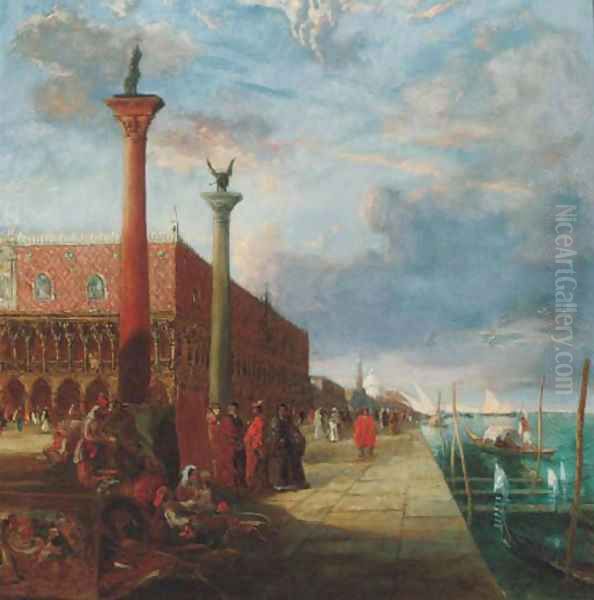
While he may have worked in the shadow of some towering figures of his era, Holland carved out a distinct artistic identity characterized by a profound sensitivity to light, a bold yet nuanced use of colour, and an ability to evoke the unique atmosphere of a place. His Venetian scenes, in particular, remain captivating for their luminous quality and romantic sensibility. As a key figure within the British watercolour tradition and a masterful interpreter of European landscapes, James Holland's work continues to delight viewers and offers valuable insights into the artistic currents of the Victorian age.